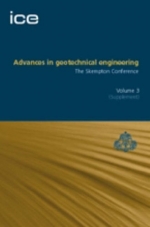Tab Article
This two-volume set presenting the proceedings of the Skempton Memorial Conference on Advances in Geotechnical Engineering held at the Royal Geographical Society, London, on 29–31 March 2004.
With the conference's commemorative theme, the first volume reprints the Royal Society of London's short biographical memoir on ansi-Professor Sir Alec Skempton and offers a set of invited articles that reflect on his contributions to engineering geology, slope stability and the history of civil engineering.


